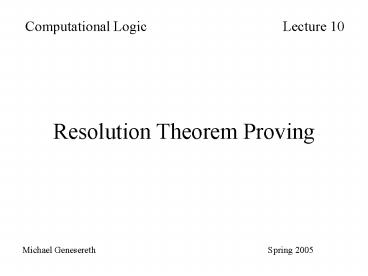Resolution Theorem Proving - PowerPoint PPT Presentation
1 / 29
Title:
Resolution Theorem Proving
Description:
Resolution Theorem Proving. Computational Logic Lecture 10. Michael Genesereth ... Every horse can outrun every dog. Some greyhound can outrun every rabbit. ... – PowerPoint PPT presentation
Number of Views:47
Avg rating:3.0/5.0
Title: Resolution Theorem Proving
1
Resolution Theorem Proving
Computational Logic Lecture 10
Michael Genesereth Spring 2005
2
Plan
First Lecture Unification Relational Clausal
Form Second Lecture Resolution
Principle Resolution Theorem Proving Third
Lecture True or False Questions Fill in the
Blank Questions Residue Fourth
Lecture Strategies to enhance efficiency
3
Propositional Resolution
4
Relational Resolution I
5
Example
6
Example
7
Example
Everybody loves somebody. Everybody loves a
lover. Show that everybody loves everybody.
8
Example (continued)
9
Example (concluded)
10
Harry and Ralph
Every horse can outrun every dog. Some greyhound
can outrun every rabbit. Show that every horse
can outrun every rabbit.
11
Harry and Ralph (continued)
12
Harry and Ralph (continued)
13
Harry and Ralph (concluded)
14
Example
Given ?x.?y.(p(x,y) ? q(x,y)) ?x.?y.(p(x,y) ?
q(x,y)) Prove ?x.?y.(p(x,y) ? q(x,y))
15
Example (continued)
?x.?y.(p(x,y) ? q(x,y)) ?x.?y.((?p(x,y) ?
q(x,y)) ? (p(x,y) ? ?q(x,y))) (?p(a,y) ?
q(a,y)) ? (p(a,y) ? ?q(a,y)) ?p(a,y),
q(a,y) p(a,y), ?q(a,y) ?x.?y.(p(x,y) ?
q(x,y)) p(x, f(x)) ? q(x, f(x))
p(a,f(x)), q(a,f(x))
16
Example (continued)
Negate the goal ?x.?y.(p(x,y) ? q(x,y)) ?
??x.?y.(p(x,y) ? q(x,y)) Convert to Clausal
Form ??x.?y.(p(x,y) ? q(x,y)) ?x.?y.?(p(x,y)
? q(x,y)) ?x.?y.(?p(x,y) ? ?q(x,y)) ?p(x,y) ?
?q(x,y) ?p(x,y), ?q(x,y)
17
Example (concluded)
1. ?p(a,y), q(a,y) Premise 2. p(a,y),
?q(a,y) Premise 3. p(x, f(x)), q(x,
f(x)) Premise 4. ?p(x,y), ?q(x,y) Negated
Goal 5. q(a, f(a)) 1, 3 6. p(a, f(a)) 2,
3 7. ?p(a, f(a)) 4, 5 8. 6, 7
18
Problem
19
Relational Resolution II
20
Example
21
Problem Without Renaming
1. r(a,b,u1) Premise 2. r(b,c,u2) Prem
ise 3. r(c,d,u3) Premise 4.
r(x,z,f(v)),?r(x,y,f(f(v))),?r(y,z,f(f(v))) Prem
ise 5. ?r(a,d,w) Goal 6. r(a,z,f(v)),?r(b,z
,f(f(v))) 1,4 7. ?r(b,d,f(f(v))) 5,6 8.
?r(a,y,f(f(v))),?r(y,d,f(f(v))) 4,5 9.
?r(b,d,f(f(v))) 1,8
22
Solution With Renaming
1. r(a,b,u1) Premise 2.
r(b,c,u2) Premise 3. r(c,d,u3) Premi
se 4. r(x,z,f(v)),?r(x,y,f(f(v))),?r(y,z,f(f(v)
)) Premise 5. ?r(a,d,w) Goal 6.
?r(a,y6,f(f(v6))),?r(y6,d,f(f(v6))) 4,5 7.
?r(b,d,f(f(v7))) 1,6 8. ?r(b,y8,f(f(f(v8))
)),?r(y8,d,f(f(f(v8)))) 4,7 9.
?r(c,d,f(f(f(v9)))) 2,8 10. 3,9
23
Problem
24
Factors
If a subset of the literals in a clause ? has a
most general unifier ?, then the clause ?'
obtained by applying ? to ? is called a factor of
?. Clause p(x),p(f(y)),r(x,y) Factors p(f(y)),r
(f(y),y) p(x),p(f(y)),r(x,y)
25
Relational Resolution III (Final Version)
26
Example
27
Need for Original Clauses
1. p(a,y), p(x,b) Premise 2.
?p(a,d) Premise 3. ?p(c,b) Premise 4.
p(x,b) 1,2 5. 3,4 1. p(a,y),
p(x,b) Premise 2. ?p(a,d) Premise 3.
?p(c,b) Premise 4. p(a,b) Factor of 1
28
Provability
A resolution derivation of a clause ? from a set
? of clauses is a sequence of clauses terminating
in ? in which each item is (1) a member of ?
or (2) the result of applying the resolution to
earlier items. A sentence ? is provable from a
set of sentences ? by resolution if and only if
there is a derivation of the empty clause from
the clausal form of ????. A resolution proof
is a derivation of the empty clause from the
clausal form of the premises and the negation of
the desired conclusion.
29
Soundness and Completeness
Metatheorem Provability using the Relational
Resolution Principle is sound and complete for
Relational Logic (without equality).































